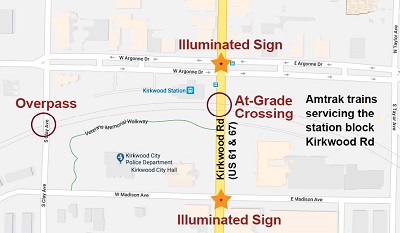Railway-Highway Crossings (Section 130) Program
NOTEWORTHY PRACTICE
Using Traveler Information to Mitigate Blocked Rail-Highway Crossings
Local Approaches to Signing Lead to Success


FHWA-SA-18-072
At-grade rail-highway crossings that are blocked by slow-moving or stopped trains increase risks to public safety at both rural and urban locations. For example, emergency responders may be prevented from reaching individuals facing life-threatening health crises, pedestrians or children may attempt to cut through idling trains to complete their crossing, and commercial vehicles may detour onto local streets to reach their destination, endangering citizens and other travelers by using roads not designed to safely convey large, heavy trucks.
Pointing the Way to a Safer Crossing in Kirkwood, Missouri

Left: Neon signs, which are no longer compliant with the Manual on Uniform Traffic Control Devices (MUTCD), have served for decades to direct drivers away from a busy at-grade crossing in downtown Kirkwood, MO. Source: FRA. Right: New, MUTCD-compliant, signal-actuated LED signs will replace the older signs. Source: City of Kirkwood.
The City of Kirkwood, a suburb of St. Louis, is located along the Jefferson City Subdivision of the Union Pacific Railroad. The town of about 30,000 people features several rail-highway crossings and sees an average of 28 trains per day pass through. This is particularly challenging on Kirkwood Road, a busy north-south arterial with an at-grade crossing. Amtrak trains at the adjacent Kirkwood Station regularly block the crossing four times each day as passengers board or disembark. Freight trains also pass through the crossing and block traffic for shorter periods. Since the average annual daily traffic on Kirkwood Road is about 29,000 vehicles, even if the crossing is blocked only briefly, traffic can quickly back up.
Through 2018, the city used illuminated detour signs on the north and south approaches advising drivers to use the overpass a block west of the crossing. Ted Dunkmann, Kirkwood's city engineer, estimates that the signs successfully diverted up to a thousand vehicles per day from the crossing. "Any time you can divert cars around a crossing so there's no potential for conflict, that's a good thing," Dunkmann noted.

Locations of illuminated signs in advance of the Kirkwood Road at-grade crossing and the nearby overpass. Original map © Google 2018.
The original signs were neon, and had been in service for more than 30 years. Due to the age of the technology, the signs remained continuously lit and could not be connected to the single controller that ran the downtown signal system. In 2018, using Congestion Mitigation and Air Quality funds, Kirkwood began work to upgrade the signal systems on Kirkwood Road. The old signs will be retired and replaced with actuated signals, new controllers, and warning signs that use light-emitting diode technology and are compliant with the Manual on Uniform Traffic Control Devices. "We're fortunate to have an overpass just a block away, which is why we can do preemption and diversion," Dunkman said.
Warning Signs Keep Traffic Moving in Jackson, Mississippi

Jackson is a rail hub in central Mississippi, with several rail lines transporting passengers and freight through the area. State Street, a major arterial, is bisected by two rail line crossings not far from Interstate 55. Because the off-ramp to State Street leads straight to the crossing, traffic often backs up onto the Interstate when a train is present, and there is no alternate route available for vehicles once they have exited the Interstate, and. As many as 30 to 40 trains move through this location over a 24-hour period, making it essential to keep traffic moving safely.
Until 2008, gates installed on the KCS line were broken on a regular basis, indicating vehicles were repeatedly trying to make it through the gates before they closed.

Other agencies are using similar approaches that have also proven effective. On I-265 in Louisville, KY, trains entering and exiting a nearby car factory block Chamberlain Lane. This MUTCD-compliant warning sign advises traffic to use the following exit (Exit 32) to avoid the blockage. Dual flashing yellow lights above the sign are triggered when the warning system at the crossing is activated. Source: Google Maps © 2018.
To address both the safety risks from impatient drivers attempting to "beat the train" as well as concerns expressed by motorists who often took the exit not knowing that their route would be blocked, the City of Jackson began to work with the KCS and CN Railroad, the owners of the tracks, on a way to warn drivers when the crossing was blocked ahead of time. This would allow drivers to continue on to the next exit, avoiding the crossing entirely but still reaching their destination via an alternate route.
John Dinning, Manager of Public Works for CN Railroad, recalls, "We were brain storming, trying to put low-cost ideas together." At the time, variable message boards were still a fairly new technology, he noted, and were cost prohibitive.
They opted for a less costly solution: installing a post-mounted warning sign with train-activated flashers prior to the interstate off-ramp. The presence of a train at the State Street crossing triggers a radio link, which causes two yellow lights to begin flashing. The warning sign reads: "State Street – Expect Train When Flashing."
"It's a simple solution, but it catches probably 95 percent of the people who drive the road every day," Dinning added, noting that the sign has been successful enough that it has led to similar signs being placed at other off-ramp locations in the area that are affected by at-grade crossings.
Page last modified on November 27, 2019
